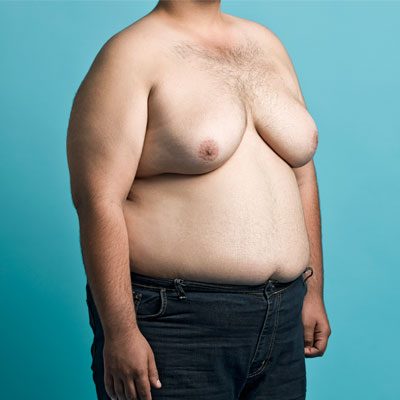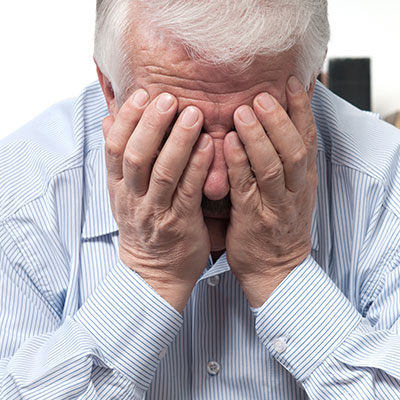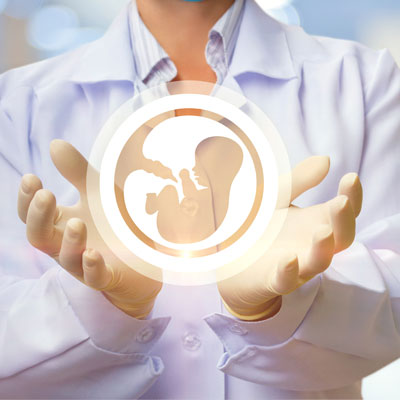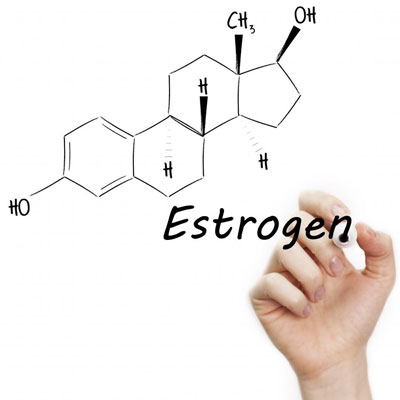Gynecomastia and Testosterone Therapy: Etiology, Symptoms, Causes and Treatment
Contents

Testosterone is the primary male androgen sex hormone. It is responsible for sex drive, erectile functions (in part), spermatogenesis, muscle growth, red blood cell production, bone mineral density, hair growth, metabolism, brain functions, and more. Testosterone is also not an end hormone – the body can convert it through enzyme interaction into one of two other hormones:
- Estradiol via the enzyme aromatase
- Dihydrotestosterone (DHT) via the enzyme 5-alpha reductase
As these two enzymes seek out free testosterone in the bloodstream, they change the dynamics of hormone balance in the body. Individuals who are overweight create more aromatase through belly fat which can offset the testosterone to estrogen balance. As the body converts more free testosterone into estradiol, estrogen levels rise, and testosterone levels decline. Excess estrogen may cause male breasts to grow.
Men inquiring about gynecomastia and testosterone replacement therapy (TRT) often find that the use of TRT can help return breasts to their normal size.
Gynecomastia is often caused by hormonal fluctuations, leading to an enlargement of male breast tissue.
What Is Gynecomastia?
The enlargement of male breast tissue is called gynecomastia and can occur in one or both breasts. Unilateral gynecomastia means that only one breast suffers from enlargement. Bilateral gynecomastia occurs when both breasts experience a glandular proliferation of breast tissue.
Gynecomastia is different from a condition called Trusted sourceWhat is Pseudo-gynecomastia?gynecomastia.orgGo to sourcepseudogynecomastia (lipomastia) that occurs when an increase in fat deposits in the breast is unaccompanied by glandular proliferation. Pseudogynecomastia occurs most often in men who are obese or those who have lost considerable amounts of weight. The result is a significant increase in fatty deposits in the breast tissue.
While pain or tenderness of the breasts is possible with gynecomastia, it is not likely with pseudogynecomastia.
As we continue to understand the connection between a reduction in gynecomastia and testosterone therapy’s role in the process, we find that men with pseudogynecomastia may also develop the glandular enlargement indicative of gynecomastia. The excess fatty tissue in the male breasts can also synthesize aromatase, causing an increase in testosterone to estradiol conversion. Treatment with testosterone therapy along with an estrogen inhibitor can help reduce overgrown male breast tissue.
Other potential causes of gynecomastia not related to testosterone or obesity include:
- Exposure to estrogen-like chemicals such as phytoestrogens and xenoestrogens in foods and grooming or household products
- Tumors in the pituitary gland, hypothalamus, or testicles can alter hormonal balance and influence breast tissue growth
- Use of Propecia for hair loss which can increase testosterone levels (and therefore estrogen conversion) by decreasing DHT conversion
- Tagamet use for heartburn can also block testosterone receptors and offset hormone levels
- Cirrhosis or other liver issues can decrease testosterone production and cause a hormonal imbalance
- The use of HCG for fertility or weight loss can increase testosterone, thereby boosting estrogen levels
- Testosterone unable to break free from binds to sex hormone-binding globulin (SHBG) can cause lower levels of free testosterone unable to offset higher estrogen levels
Although both gynecomastia and pseudogynecomastia can be present, their cause, appearance, and symptoms are different.
Symptoms of Gynecomastia
The male androgen hormone testosterone helps to keep estrogen levels low and prevent the development of gynecomastia. In men with low testosterone and gynecomastia, breast tissue enlargement often occurs because of increased estrogen levels. That leads us to one of the first, often early signs of gynecomastia – weight gain. Long before breast tissue enlargement occurs, a man may notice that his waistline is expanding. If weight gain is not due to increased food consumption, it may be due to hormonal imbalance. Men with Low T are more likely to be overweight than those who have normal testosterone levels.
Symptoms that are indicative of gynecomastia and testosterone therapy need include:
- Tenderness of the breasts
- Enlarged or swollen breast tissue
- Unevenly sized breasts
Pain in the breasts or nipple discharge could indicate more serious concerns and warrant a call to one’s doctor.
Enlarged breasts are the primary indicator of gynecomastia in men.
Why Does Low Testosterone Contribute to Gynecomastia?
As we look at the connection between low testosterone levels and gynecomastia, we first examine the impact of testosterone on metabolism. Aside from human growth hormone (HGH), testosterone is the other critical hormone that influences how the body metabolizes the food it consumes. A so-called “sluggish” metabolism occurs when hormonal influence declines, causing the body to convert the consumed food into stored fat rather than immediately usable energy. As the fat cells in the body expand, they increase production of aromatase.
Excess aromatase causes the body to convert more testosterone into Trusted sourceEstradiolHormone Health NetworkGo to sourceestradiol which further increases weight gain. Why? Estradiol is a hormone that influences fat storage. The more estradiol in the bloodstream, the more fat the body will store. The result is a vicious cycle that continues to increase aromatase and testosterone conversion to estradiol.
Fat tissue also produces the hormone leptin, which, in excess, leads to leptin resistance. The brain thinks it is starving, so it forces the body to hold onto stored fat reserves. When leptin levels are high, the pituitary gland decreases the production of Trusted sourceLuteinizing HormoneHormone Health NetworkGo to sourceluteinizing hormone (LH) and follicle stimulating hormone (FSH) which impact testosterone and sperm production. Testosterone levels continue to decline, and estrogen takes over the lead role, causing glandular breast tissue cells to increase growth.
The most likely time for breast tissue enlargement in males, following infancy and puberty is between the ages of 50 and 69. By that time, testosterone levels have been in decline for over 20 years. The hormonal imbalance between estrogen and testosterone levels peaks, causing 1 in 4 men to experience breast tissue growth.
Females have larger breasts due to the higher estrogen to testosterone ration. Since males naturally have more testosterone, it helps maintain more muscle in their bodies and less fat and breast tissue. When that balance is out of whack, men may experience the same type of breast tissue growth as women.
Next up, we look at the relationship between gynecomastia and testosterone therapy, and why increasing testosterone levels can lead to breast tissue growth.
Men who have low testosterone often have higher estrogen levels which can influence breast tissue growth.
Does Testosterone Therapy Cause Gynecomastia?
It would seem likely that if low testosterone is the cause of breast enlargement in males, that TRT would reduce breast growth and size. However, that is not always the case. There is also a connection between testosterone therapy and gynecomastia that occurs in some men. Luckily, it often rectifies itself.
In the early stages of treatment with testosterone therapy, testosterone levels may rise considerably. Depending on how much belly fat a man has, that may also mean more estrogen conversion. That is why some men notice an increase in breast tissue size soon after they begin TRT.
To counter the increase in estrogen conversion, the hormone specialist may prescribe an estrogen blocker called anastrozole. The purpose of this medication is to inhibit testosterone conversion into estradiol so that the body can achieve proper hormonal balance. As a result, excess breast tissue growth typically reverses naturally.
As we stated, this connection between gynecomastia and testosterone therapy is typically short-lived for most men. As testosterone levels continue to rise, they offset the estrogen imbalance, reducing breast growth often within a few weeks.
Although testosterone therapy increases testosterone levels, it often boosts estrogen levels, at least at first, causing a temporary increase in breast tissue.
Why Do Some Men Develop Gynecomastia from Testosterone Therapy?
Testosterone therapy does not always lead to an increase in male breast size. Although there is no necessary correlation between testosterone gel and gynecomastia as compared to other treatments, men who use the gel are subject more to skin irritation. Both testosterone gels and patches can increase the risk of allergic skin reactions, rashes, and irritation. Also, testosterone gel used nearer to the chest may cause a buildup of testosterone closer to breast tissue. This could influence breast tissue growth.
Another relationship between gynecomastia and testosterone therapy occurs in men who use testosterone illegally. In this instance, we speak of steroid use for bodybuilding, sports performance, or other enhancement purposes.
When using testosterone without doctor authorization, you unnaturally increase testosterone hormone levels. Remember, an increase in testosterone levels can also lead to higher estrogen levels. A man who goes off on his own and purchases both testosterone and anastrozole may be unwittingly offsetting his delicate hormone balance. Remember, although too much estrogen can be detrimental to the male body, too little is also a problem. Men need estrogen for sexual function and bone health, as well.
Steroid use and testosterone abuse can offset hormone levels and sometimes cause increased breast tissue growth.
How Do You Treat Gynecomastia?
Treatment for gynecomastia often depends on why there is breast tissue growth. If we are talking about low testosterone and gynecomastia, then treatment with testosterone replacement therapy will often do the trick. Of course, the doctor may prescribe anastrozole to block estrogen conversion of the increased testosterone.
Other options for the treatment of gynecomastia include:
- Tamoxifen and Raloxifene – approved for breast cancer treatment, used off-label to treat gynecomastia
- Liposuction – only beneficial for pseudogynecomastia when the problem is caused by fatty deposits and not glandular growth
- Surgery – as with a mastectomy for breast cancer, endoscopic surgery can remove glandular breast tissue through a small incision
- Weight loss – losing weight often increases testosterone levels without raising estrogen levels and can help reduce breast tissue growth
Understanding the relationship between gynecomastia and testosterone therapy can help determine the best way to reduce breast tissue growth.
If gynecomastia is due to Low T, then treatment with testosterone therapy is often the best option.
Can You Avoid Gynecomastia While Using Testosterone Therapy?
Avoidance of the gynecomastia testosterone therapy effect is possible with proper medical supervision. Part of determining testosterone treatment also includes deciding whether a man requires anastrozole to block estrogen production. When the doctor runs blood tests, he or she will also measure estrogen levels in addition to testosterone. If a man has low testosterone and high estrogen levels and is overweight, then anastrozole will inhibit estradiol conversion to reduce the risk of developing gynecomastia.
Men who have low testosterone and estrogen levels will most likely benefit from some testosterone conversion into estradiol. Remember, it is necessary to have an ideal amount of both hormones in the bloodstream.
Once you begin treatment for Low T, let your doctor know if you experience any unwanted side effects. That can help the physician make any necessary changes before gynecomastia occurs.
For further information about gynecomastia and testosterone therapy, please contact our hormone clinic. Consultations by phone with our medical professionals are confidential and provided at no cost.
Proper medical supervision will reduce the risk of developing gynecomastia while using testosterone replacement therapy.
- Robert S. Tan, MD, MBA, Kelly R. Cook, MPAS, PA-C, William G. Reilly, MD
- Ernani L Rhoden, MD, PhD, Dr. Abraham Morgentaler, MD
- Ugis Gruntmanis, MD, Glenn Braunstein, MD
- Neslihan Cuhaci, Sefika Burcak Polat, Berna Evranos, Reyhan Ersoy, and Bekir Cakir
- Ronald S Swerdloff, MD, MACP and Chiu Ming Ng, FHKAM.
- Melissa Conrad Stöppler, MD Medical Editor: David Perlstein, MD, MBA, FAAP
- George Ansstas, MD; Chief Editor: George T Griffing, MD
High Estrogen in Men After Injectable Testosterone Therapy: The Low T Experience
Treatment of testosterone-induced gynecomastia with the aromatase inhibitor, anastrozole
Gynecomastia: Clinical evaluation and management
Gynecomastia: Etiology, Diagnosis, and Treatment
Gynecomastia (Breast Enlargement in Males)





